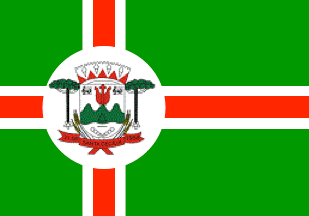 image by
Ivan Sache,
7 November 2021
image by
Ivan Sache,
7 November 2021 
Last modified: 2021-12-11 by ian macdonald
Keywords: santa catarina | santa cecília |
Links: FOTW homepage |
search |
disclaimer and copyright |
write us |
mirrors
 image by
Ivan Sache,
7 November 2021
image by
Ivan Sache,
7 November 2021
The municipality of Santa Cecília (16,918 inhabitants in 2010; 114,532 ha) is
located 300 km north-west of Florianópolis.
Santa Cecília was colonized
between 1840 and 1855 by German colonists who settled in a domain owned by
Captain José Ferreira de Souza. Tropeiros' maps dated to the 18th century shows
the place as Corisco, meaning "lightning". This recalls the death of a tropeiro
and his horse killed in 1732 during a storm. The small settlement established by
tropeiros was subsequently called Pousinho or Povinho, to be renamed to Rio
Correntes by European colonists.
The district of Santa Cecília do Rio
Correntes was established by Decree No. 49 issued on 24 February 1891, to be
elevated a municipality, as Santa Cecília, by State Law No. 348 promulgated on
21 June 1958, and inaugurated on 5 August 1958.
https://www.santacecilia.sc.gov.br/
Municipal website
Ivan Sache, 7 November 2021
An off-centred red cross, bordered white, on a green field, with the municipal shield on a white disk on the cross.
Official website at
http://www.santacecilia.sc.gov.br
Dirk Schönberger,
2 August 2012
The flag and arms of Santa Cecília are prescribed by Municipal Law No. 5
promulgated on 15 February 1971.
Article 2.
The flag representing the
municipality of Santa Cecília shall have the following design and
characteristics.
a) Shape: Rectangular
b) General characteristics: Five
horizontal stripes, in the following colors: 1a. Green stripe, 2a. White
stripe, 3a. Blue stripe, 4a. White stripe, 5a. Golden yellow stripe.
c)
Special characteristics: A central circle, of white background, charged with
the following elements: in the foreground, a black and white cow's head and two
yellow wheat spikes; in the background, green (canopy) and brown (trunk)
Brazilian pines; a light yellow and golden yellow lasso near the central
circle. In the circle's upper part, on the right, in black letters, "SANTA
CECÍLIA". In the lower part, on the left, the date of establishment of the
municipality, "28-6-58 - SC", also in black letters.
The general and
special characteristics mean:
The green, blue and yellow stripes have the
same meaning as the colors of the national flag. The two white horizontal
stripes means peace and harmony to be preserved among citizens and with the
municipal power.
The cow's head represents cattle-breeding, a main source of
income for the municipality, while the two wheat spikes represent agriculture,
also a relevant source of income.
The two Brazilian pines, in the
background, have a dual meaning: timber extraction industry and the related
industries, which are factors of municipal progress, and physiographic
characteristics of the region. The lasso divided into two parts complements the
symbol of cattle-breeding, already represented by the cow's head.
Article 3.
The coat of arms representing the municipality of Santa Cecília
shall have the following shape and characteristics. A cogwheel inscribed in it;
in the foreground, right, a cow's head, and left, two wheat spikes. In the
background, in the center, a Brazilian pine; behind, mountains, then pastures.
Crossing the cogwheel, in a semi-circular pattern, a scroll inscribed
"PREFEITURA MUNICIPAL DE SANTA CECÍLIA - SC".
The charges composing the
municipal coat of arms have the following meaning. The cogwheel represents
industries established in the municipality, factors of economical progress. The
cow's head, the two wheat spikes and the Brazilian pines have the same meaning
as on the municipal flag (Article 1). The pastures in front of the mountains
symbolize, jointly with the cow's head, cattle-breeding. The background
symbolizes local topography.
https://leismunicipais.com.br/a/sc/s/santa-cecilia/lei-ordinaria/1971/1/5/lei-ordinaria-n-5-1971-cria-bandeira-e-o-escudo-municipal-conforme-especifica
Leis Municipais database
The flag in current use seems quite
different from the prescribed one.
Photo
http://diretoriadeculturasc.blogspot.com/2013/03/blog-post_4742.html
Ivan Sache, 7 November 2021